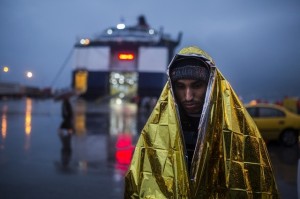More barriers go up in our borderless battlefield

A man wrapped in a thermal blanket waits to get on board a ferry bound to Piraeus at the port of Mytilene, on the Greek island of Lesbos
This is the second year running to have started with a major European country warning against the threat posed by radical Islam. In January 2015, French prime minister Manuel Valls declared that his country was at war with this particular species of extremism. He was speaking after the Charlie Hebdo attack, which occurred one year ago today. And 2016 has begun with Germany’s interior minister, Thomas de Maiziere, describing the security situation in his country as fragile. Only increased intelligence cooperation can keep Germany safe from ISIL, he said. The remarks came after parts of Munich had to be sealed off because there was warning of a New Year’s Eve terrorist attack.
There is little doubt that Europe is now united in fear (if divided by mistrust) over ISIL’s influence and the intentions of its supporters. This is probably the first time since the Second World War that New Year celebrations across several European capitals have been either toned down or cancelled. Politicians and the public are acting as if there is a war on and unlike in the summer of 1914, no one is pretending it will all be over by Christmas.
Unlike a hundred years ago, the trenches being dug are digital and data. There is a sense that everyone is hunkering down for a long fight.
There is some logic in this. The changing nature of warfare means that the battlefield is everywhere now and that the weapons deployed are no longer only military. It is not just the threat posed by ISIL and other extremist groups. China’s 13-year-old strategy called “Three Warfares” – legal, psychological and media operations – also poses a ceaseless challenge.
That’s why for all the talk of greater cooperation, 2016 is likely to be a year of more borders across Europe.
The speed with which walls can go up became clear with Sweden’s announcement on the first Monday of the new year that it was imposing identity controls on travellers from Denmark and other neighbouring countries. This affects thousands of people. Not least, the estimated 20,000 commuters who daily cross Oresund, Europe’s longest road and rail bridge, between the Swedish cities of Malmo and Lund and the Danish capital, Copenhagen. The logistical problems are big enough, the symbolic ones are even larger.
It is the first time in more than 50 years that citizens of Nordic Passport Union countries will be subject to such measures. The Nordic agreement predates the increasingly shaky 20-year-old Schengen zone and the significance of the attempt at fortification was painfully obvious in the tears that accompanied the announcement by Swedish deputy prime minister Asa Romson.
Ms Romson, who belongs to the emotive Green Party, has admitted she was weeping in part because it was a reversal of Sweden’s traditional open-door policy towards people fleeing war and persecution.
Denmark responded quickly by tightening its border controls with Germany. Roughly a month ago, Germany reinstated controls at its border with Austria, and France at its border with Belgium. Everyone calls the new restrictions in the Schengen borderless zone “temporary” but no end date can realistically be set. The new walls – it’s immaterial if they comprise rules or bricks – affect millions. At least 50 per cent of the Schengen zone’s population – 400 million people across 26 countries – live within an hour’s drive of their national border. A spokesman for the commuters between Sweden and Denmark likened the move to a new Berlin Wall. And this new year of new borders is still barely a week old.
But why should anyone be surprised? The battle against extremist groups is being fought in a grey zone. There is no formal declaration of war, but the conflict ranges across military, media, economic, cyber and psychological operations. It is the sort of engagement in which hacking a website or an exchange on social media might be just as important as a strategic military plan. And extremist groups are not the only shadowy warriors on this new borderless battlefield.
Last year, there were several cyberattacks on US government agencies and big corporate entities, among others. The attacks, allegedly linked to China, Russia, Iran and ISIL’s ideological supporters, are part of what military theorists are now calling “hybrid,” “full-spectrum” or “non-linear” operations. These are meant to be war without battlefield kinetics or much blood. Unsurprisingly, cyber threats topped the list of business concerns on a so-called risk map issued by a large global consultancy group. The report noted that “more nation states [will] engage in cyber operations and criminal attacks on corporate networks [will] become increasingly damaging”.
This is where Europe’s Cyber Security Directive, the recently agreed rules that aim to strengthen continent-wide resilience to cyberattacks, comes in. If all goes to plan, European member states will, by mid-2018, implement the directive in national law. This will include the mandatory reporting of security breaches for key infrastructure providers in energy, transport, financial markets, health and water. But throwing up another frontier may not necessarily mean greater security, just more barriers for continent-wide operators in the communications, cloud computing, e-commerce, healthcare, energy, banking and transport sectors.
What could the European Union say it has achieved in 2016 if passport-free travel and continent-wide commercial operations were to become casualties of the borderless battlefield?
Rashmee Roshan Lall is a writer on world affairs
On Twitter: @rashmeerl

